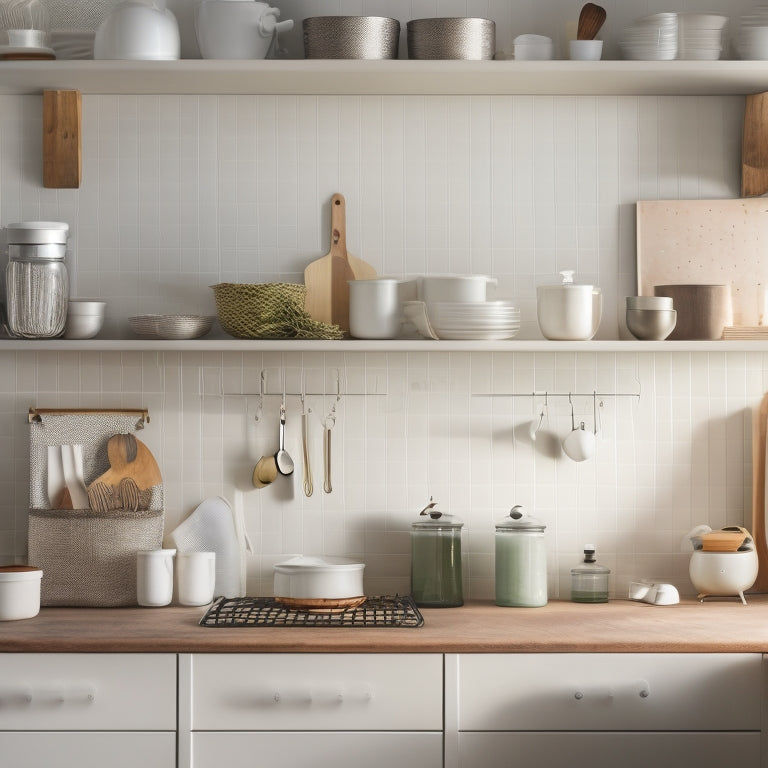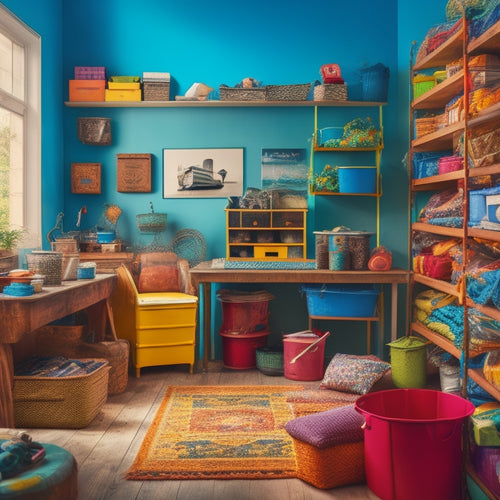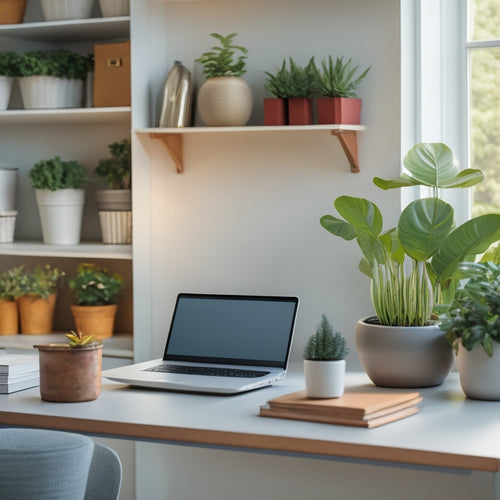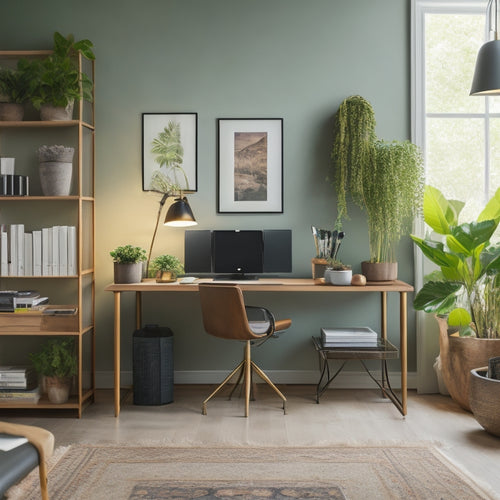
Simplify Your Space: Essential Kitchen Organization Hacks
Share
You're tired of wasting time maneuvering through your cluttered kitchen. To simplify your space, start by clearing countertops and sorting items into categories to identify what to keep, donate, or discard. Next, maximize cabinet storage by optimizing shelf heights and using vertical dividers. Create functional zones on countertops and allocate space for tasks like chopping stations. Consider concealing appliances, utilizing vertical storage, and implementing a labeling system in your pantry. By implementing these essential kitchen organization hacks, you'll be well on your way to a more efficient kitchen - and there's more to explore to take your kitchen to the next level.
Key Takeaways
• Clear countertops by categorizing items, getting rid of broken or redundant ones, and utilizing appliance garages for a clutter-free space.
• Maximize cabinet storage by optimizing shelf heights, using vertical dividers, and storing heavy items strategically for easy access.
• Designate functional zones on countertops for specific tasks, such as chopping stations, to optimize workflow and reduce traffic congestion.
• Conceal kitchen appliances using garages, pull-out cabinets, or drawers to minimize clutter and create a more organized kitchen.
• Utilize vertical storage solutions like shelves, racks, and hooks to make the most of available space and keep frequently used items within reach.
Decluttering Kitchen Countertops Fast
Decluttering Kitchen Countertops Fast
Clear everything off your kitchen countertops and sort items into categories, such as baking supplies, cooking utensils, and appliances, to quickly identify what you need to keep, donate, or discard. This quick decluttering tip will help you prioritize what's essential and what's not.
Once you've sorted your items, get rid of anything broken, outdated, or redundant. This will free up valuable space on your countertops and make meal prep a breeze.
Next, focus on organizing your appliances. Consider investing in a utensil organizer or an appliance garage to keep frequently used items within easy reach. For space-saving solutions, look for compact or multi-functional appliances that can perform multiple tasks.
Maximizing Cabinet Storage Space
When you're maximizing cabinet storage space, you're not just looking for ways to fit more stuff in - you're aiming to create a system that makes sense.
You'll want to start by optimizing shelf heights to fit your most-used items, then use vertical dividers to keep similar items together.
From there, you can focus on storing heavy items in a way that makes them easy to access.
Optimize Shelf Heights
Optimize Shelf Heights
To maximize cabinet storage space, you'll want to tailor your shelf heights to fit the items you use most frequently, ensuring that everyday essentials are easily accessible. By adjusting shelf heights, you can create a more functional and organized pantry.
Here's a general guideline for organizing pantry shelves:
| Shelf | Height | Items |
|---|---|---|
| Top | 12-18 inches | Infrequently used items (e.g., special occasion dishes) |
| Middle | 8-12 inches | Frequently used items (e.g., plates, bowls, cups) |
| Bottom | 6-8 inches | Heavy items (e.g., pots, pans, cookbooks) |
| Adjustable | Varies | Items of varying sizes (e.g., appliances, cookware) |
| Lazy Susan | Varies | Hard-to-reach items (e.g., spices, oils) |
Use Vertical Dividers
To prevent clutter from building up and optimize your cabinet storage space, install vertical dividers to separate and categorize items within your cabinets. This simple hack will help you make the most of your cabinet real estate, ensuring that everything has its designated place.
You'll be able to find what you need quickly and easily, saving you time and frustration.
Use wall hooks to hang items like pots, pans, and utensils, freeing up shelf space for other essentials. Consider installing hanging baskets to store snacks, spices, or oils, keeping them organized and within reach.
When it comes to shelf organizers, look for adjustable dividers that can be customized to fit your specific needs. These will help you keep similar items together, making it easier to find what you need when you need it.
Store Heavy Items
You can further maximize your cabinet storage space by strategically storing heavy items, like appliances and cookware, on lower shelves to prevent them from falling and making a mess. This not only keeps your kitchen organized but also ensures safety. When storing heavy items, it's essential to practice proper lifting techniques to avoid straining your back.
| Item | Storage Location | Safety Precautions |
|---|---|---|
| Heavy Cookware | Lower Shelves | Bend at the knees, keep the cookware close to your body, and lift with your legs |
| Small Appliances | Mid-Level Shelves | Ensure the shelf is sturdy, and the appliance is secure to prevent it from falling |
| Pots and Pans | Upper Shelves | Use step stools or ladders with caution, and always maintain three points of contact |
Streamlining Kitchen Workflow Areas
As you work to streamline your kitchen's workflow areas, you'll want to focus on creating efficient zones and pathways.
Start by identifying the tasks you perform most frequently, such as food prep or cooking, and assign specific countertops or stations to each task.
Zone Your Countertops
Designate specific zones on your countertops to streamline kitchen workflow areas, allowing you to efficiently prep, cook, and serve meals. By creating designated zones, you're able to maximize your counter space and reduce clutter. Identify the tasks you perform most frequently in the kitchen, such as food prep, cooking, and cleaning, and allocate a specific zone for each.
Assign functional zones, like a chopping station or a coffee bar, to create a sense of order and efficiency. This will help you stay focused and avoid clutter buildup.
Balance functional organization with decorative elements, like a vase or a utensil holder, to create a visually appealing space.
Optimize Workflow Pathways
By mapping out your most frequent kitchen movements, you can identify and optimize workflow pathways to reduce traffic congestion and increase productivity. This is essential in achieving workflow efficiency, as a well-designed kitchen layout can make all the difference.
To get started, observe your daily cooking habits and note the paths you take most often. Identify the cooking zones that require the most attention, such as the sink, stove, and refrigerator. Then, analyze how you move between these zones and pinpoint any bottlenecks or areas of congestion.
Here's a simple framework to help you optimize your workflow pathways:
| Cooking Zone | Primary Task | Optimized Pathway |
|---|---|---|
| Sink | Washing vegetables | Place a trash can nearby to minimize walking distance |
| Stove | Cooking meals | Position utensils and spices within easy reach |
| Refrigerator | Storing ingredients | Designate a specific area for frequently used items |
Hiding Kitchen Appliances Effectively
You can reclaim valuable counter space and create a more streamlined look by strategically concealing kitchen appliances.
One effective way to do this is by incorporating an appliance garage into your kitchen design. This hidden storage space allows you to tuck away bulky items like stand mixers, blenders, and coffee makers, keeping them out of sight but still easily accessible.
Another concealment solution is to install pull-out cabinets or drawers that can house appliances like toasters, microwaves, and food processors. By doing so, you'll be minimizing clutter and creating a more organized, efficient kitchen.
When selecting concealment solutions, consider the size and shape of your appliances, as well as the overall aesthetic you want to achieve. By thoughtfully hiding your kitchen appliances, you'll be able to enjoy a more streamlined, clutter-free space that's both functional and visually appealing.
Creating a Functional Pantry
Creating a Functional Pantry
In order to maximize storage and efficiency, organize your pantry into zones, assigning a specific area for each type of food or cooking essential, such as baking supplies, snacks, or spices. This will enable you to quickly find what you need, reducing meal prep time and stress.
To take your pantry organization to the next level:
-
Implement a labeling system: Use clear labels to identify contents, expiration dates, and storage instructions, ensuring you can easily identify what's inside each container.
-
Conduct regular pantry inventory: Schedule a monthly review to discard expired items, update your inventory, and plan meals based on what you already have.
-
Store heavy items at the bottom: Keep heavier items, like canned goods, on lower shelves to prevent them from falling and causing a mess.
- Designate a 'first-in, first-out' shelf: Reserve a shelf for new items, ensuring older products are consumed before they expire.
Utilizing Vertical Storage Options
Make the most of your kitchen's vertical space by installing shelves, hooks, or a pegboard on walls and ceilings to store items like pots, pans, utensils, and spices, freeing up valuable counter and cabinet space. This won't only declutter your kitchen but also make it more functional. You'll be able to easily access what you need, when you need it.
Consider hanging pots and pans from hooks or a pegboard on the ceiling or a wall. This will keep them organized, out of the way, and add a touch of elegance to your kitchen.
Wall-mounted shelves can also be used to store less frequently used items, such as special occasion dishes or infrequently used cookbooks. By utilizing vertical storage options, you'll be able to maximize your kitchen's storage capacity without sacrificing style or functionality. Plus, you'll have more room to focus on what matters – cooking up a storm!
Simplifying Kitchen Drawer Organization
Five kitchen drawers can quickly become cluttered with utensils, gadgets, and cookware, making it difficult to find what you need when you need it.
To simplify your kitchen drawer organization, you need to implement efficient storage solutions that maximize space and provide easy access to your essentials.
Here are some strategies to get you started:
-
Install drawer organizers: Use dividers, inserts, or trays to separate utensils, cookware, and gadgets, keeping them organized and easily accessible.
-
Utilize vertical space: Make the most of your drawer's vertical space by using stackable containers or baskets to store items like lids, plates, or cups.
-
Designate zones: Assign specific zones within each drawer for specific items, such as a 'baking zone' or a 'cooking zone', to maintain order and reduce clutter.
- Store frequently used items front and center: Place your most frequently used items in easy-to-reach locations, saving you time and effort when cooking.
Optimizing Corner Cabinet Space
How do you conquer the often-wasted space in your kitchen's corner cabinets, where pots, pans, and cookware tend to get stuck and forgotten? By implementing smart organizational solutions, you can transform these areas into functional and accessible storage spaces.
Here are some effective ways to optimize your corner cabinet space:
| Solution | Benefits | Installation |
|---|---|---|
| Lazy Susan | Easy access to items, reduces clutter | Simple installation, no tools required |
| Pull-out Shelves | Increases storage capacity, easy to clean | Requires some DIY skills, moderate installation |
| Swing-out Trays | Maximizes vertical space, easy to use | Moderate installation, some DIY skills required |
| Corner Drawers | Customizable storage, easy to access | Professional installation recommended, complex installation |
| Adjustable Shelves | Flexible storage options, easy to adjust | Simple installation, no tools required |
Frequently Asked Questions
How Do I Maintain My Organized Kitchen Over Time?
You'll need to defend your kitchen against a tidal wave of clutter, daily! To maintain your organized space, you're preventing chaos by establishing long-term maintenance habits, utilizing time-saving tips, and efficient systems that'll keep your kitchen running like a well-oiled machine.
Can I Organize My Kitchen on a Tight Budget?
You can definitely organize your kitchen on a tight budget! Look for budget-friendly storage options like repurposed containers and DIY shelving, and get creative with solutions like using the back of a door for extra storage space.
What Are the Best Organization Tools for Small Kitchens?
"Did you know 68% of homeowners consider kitchen organization a top priority? You'll maximize your small kitchen's potential with space-saving solutions like wall-mounted shelves and creative storage, embracing a minimalist design for a functional layout."
How Do I Organize Kitchen Items I Rarely Use?
You'll free up valuable space by storing seasonal appliances, like holiday cookie cutters, in labeled bins or containers, and designating occasional use solutions, such as a "rarely used" shelf or cabinet, to keep items accessible yet out of the way.
Can I Still Have a Stylish Kitchen With Organized Spaces?
You can absolutely have a stylish kitchen with organized spaces! Incorporate stylish storage solutions and functional decor that serve a purpose, like a utensil holder or a decorative spice rack, to create a beautiful and efficient kitchen.
Related Posts
-

What Are the Best DIY Storage Hacks Online?
You're looking for the best DIY storage hacks online! You've come to the right place. From repurposing old pallets an...
-

What's the Best Home Organization Online Course?
You're looking for a high-quality home organization online course to simplify your space and life. With so many optio...
-

Boost Productivity With a Home Office Makeover
By altering your home office into a clutter-free, ergonomic, and inspiring space, you'll reveal your full productivit...


